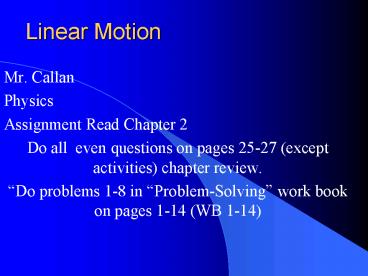Linear Motion PowerPoint PPT Presentation
1 / 29
Title: Linear Motion
1
Linear Motion
- Mr. Callan
- Physics
- Assignment Read Chapter 2
- Do all even questions on pages 25-27 (except
activities) chapter review. - Do problems 1-8 in Problem-Solving work book
on pages 1-14 (WB 1-14)
2
Equations
3
QuizHow Fast are You Moving When You Are Sitting
Still?
- What is your observation?
- What do you need to know?
4
Hint 1
- At the equator the surface of the earth rotates
around the center at about 1000 mph - At our latitude the movement is about 650 mph.
5
Hint 2
- You are revolving around the sun at about 66
thousand miles per hour,
6
Hint 3
- You are traveling around the center of the Milky
Way galaxy at about 2 million miles per hour.
7
Linear Motion
- Motion in a straight line. 1 dimensional
- Everything is in motion.
- Motion is a rate.
- Rate is a quantity divided by time.
- Since everything moves, motion is relative not
absolute. A space shuttle in orbit moves at about
8 km/sec. - But it also move very slow.
- Review How fast is this in miles/hour?
8
Speed
- A measure of distance / time.
- The rate could be mi/hr, km/sec, ft/sec etc.
- Definition Speed is the distance covered per
unit of time. Per means divided by.
9
Instantaneous Speed
- A car does not move at one speed. It changes from
zero to its maximum speed. - Your speedometer measures the cars instantaneous
speed. - It is the speed at any one point in time.
10
Average Speed
- Average speed is used to plan trips.
- It is the total distance traveled divided by the
time it took to travel the distance. - Average Speed total distance/time interval
11
Velocity
- Velocity and Speed are used interchangeably in
everyday language. - But THEY ARE NOT THE SAME.
- Velocity is speed in a given direction.
- Such as 60 mile per hour North.
12
Constant Velocity
- No change in speed
- No change in direction
- Motion is a straight line
13
Changing Velocity
- Speed could be changing
- OR
- Direction could be changing.
- OR Both
14
Acceleration
- The rate of change of velocity.
- The change in velocity/time interval.
- OR the rate of change of speed.
- The change in speed/time interval.
- deceleration is the acceleration in the negative
direction.
15
Additional Assignment
- Always look at the questions in the yellow boxes.
16
2.5 Free Fall How fast
- An apple falls from a tree. Does it accelerate
while falling? - What do we know?
- It starts from rest (velocity and acceleration
0) then gains speed. - The gain in speed indicates that the apple does
indeed accelerate.
17
Free Fall Cont.
- Why does the apple accelerate? -Gravity
- In this course we generally neglect air
resistance (friction). - Therefore, we say that the apple is freely
falling or is in free fall. - Objects in free fall increase their their
velocity by about 10 m/s each second. - What does this mean?
18
Free Fall
- a D v/ Dt 10 m/s per sec. or 10 m/s/s
- For objects in free fall a g
- More accurately g 9.8 m/s2
- Since g a D v/ Dt
- D v g Dt for an object starting at rest the
the initial velocity (vi) zero, so the
equation becomes v g Dt . - If the initial time interval (ti) is set to zero,
the the equation becomes vgt
19
Final Velocity with Initial Velocity
- If someone throws a ball, it has an initial
velocity. Vi initial velocity - To calculate the final velocity Vf, the initial
velocity is added into the equation. - Vf g Dt Vi
- Lets say a ball is thrown straight down at 2m/s
from the top of Sear Tower. How fast is it going
after 3 seconds?
20
2.6 Free Fall How far?
- An object falling from rest is moving at 10 m/sec
at one sec. But what is its average velocity?
10/2 - Time (sec) Instant Speed (m/s) Ave. Speed
- 0 0 0
- 1 10
- 2 20
- 3 30
- 4 40
21
Free Fall How Far
- The average velocity is the velocity we need for
finding the distance. (vivf)/2vave - d 1/2 gt2 Look at the units!
- meters1/2 m/(sec x sec) x sec sec
22
Free Fall How far?
- Time (sec) Instant Ave. Distance
- 0 0 0 0
- 1 10 5 5
- 2 20 15 20
- 3 30 25 45
- 4 40 35 1/2gt2
23
Reaction Time
- A bill is 15.5 cm long so if your table mate
places his/her thumb and finger over the center
and you let go of the bill can your table mate
catch the bill? - No, the bill falls 8 cm in 1/8 of a sec. Your
reaction time is much greater.
24
Lets Measure your Reaction Time
- Lab 2
- Find One and only one partner.
25
Hang Time
- Your hang time is related to how high you jump
- d ½ gt2
- Solve the vertical distance equation for time and
then have your tablemate measure how high you can
jump.
26
Graph Matching
27
2.8 Air Resistance Falling Objects
- http//www.hq.nasa.gov/alsj/a15/a15v.1672206.mov
28
Equations and Units
- vat, av/t, and ta/v
- vgt, gv/t and t v/g
- d1/2at2
- Reaction time (2d/a)1/2 , where ag9.8m/s2
29
Chapter Review Due Thursday
- Do the even problems on pages 25-27
- WB Wednesday
- Test Friday

